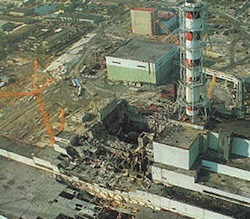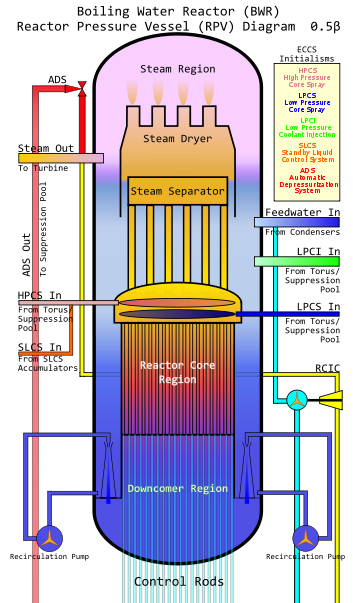Power, Point
As it happens, years ago I had the opportunity to do some consulting for a nonprofit think tank regarding nuclear power – particularly survivability in the wake of catastrophic events, likelihood of said events, and lessons to be learned from emergencies that have already happened. This was years before Fukushima and years after Chernobyl and Three Mile Island. Not being an engineer, the hardest part of the work for me was learning how various types of nuclear power plants work, and the technical realities of what went wrong (and, occasionally, right) during the worst events.
 The experience was short and I’m not sure they ever actually used any of the reports I wrote, but it did have the effect of changing forever my own personal view of nuclear power. Until some of the really futuristic opportunities like space-based solar become viable, in my opinion nuclear is the cleanest, safest, most efficient way to go. And I say that despite knowing what I know of what can go wrong.
The experience was short and I’m not sure they ever actually used any of the reports I wrote, but it did have the effect of changing forever my own personal view of nuclear power. Until some of the really futuristic opportunities like space-based solar become viable, in my opinion nuclear is the cleanest, safest, most efficient way to go. And I say that despite knowing what I know of what can go wrong.
The But-What-About effect is strong in any discussion of nuclear power. Until last year, when for whatever reason my views on nuclear entered the conversation, the But-What-About was inevitably “But what about Chernobyl?”
To which I almost always responded: “Do you know what happened at Chernobyl?”
To which they almost always responded: “Um… like… er… maybe a meltdown?”
To which I almost always responded: “Do you know what a ‘meltdown’ is?”
To which they almost always responded: “Er… like… in The China Syndrome?”
Chernobyl was a symphony of screw-ups, before, during, and after. Practically everything that could have gone wrong that night did; the key takeaway is that most of those things were predictable: The RBMK reactors used at the power plant were based on a design that was known to be flawed, one that introduced an unacceptably high void coefficient into crucial cooling lines. The reaction-choking control rods were tied to a system that moved them too slowly; even if they had been dropping at breakneck speed, to cut costs the plant designers had quite literally made them out of a material that would accelerate the reaction before slowing it down. The controllers attempted to SCRAM the reactor (Security Control Rod Ax Man, nuclear lingo for a holy-crap shutdown that evokes the early experiments of Enrico Fermi and his team) too late, using tools that were too slow and couldn’t have done it anyway. Practically no safety equipment or measuring devices – not even flashlights – were available. The plant’s technical director, who might have seen the problem in time to stop it, was in Kiev that day. And of course the Chernobyl Nuclear Power Plant was so badly engineered in a way I’m shocked it tottered on for as long as it did. Everything that went wrong on April 26, 1986 could have, to some degree or another, been predicted and corrected in advance. That it wasn’t is not nuclear power’s fault.
These days, of course, it’s “But what about Fukushima?”
The Fukushima Daiichi power plant is no Chernobyl. It used comparatively well-designed reactors with multiple layers of emergency safeties. Its personnel were highly trained and competent. They SCRAMed the reactors correctly and instituted a well-designed series of corrective and protective protocols.
Fukushima was predictable too, though: if you build something, and then you clobber it with a 9.0 earthquake and follow that up with a 50-foot tidal wave, it is going to break, no matter how well you built it and how carefully you prepared.
 So, power? It’s a big picture thing. Like any power-generation strategy, nuclear has its benefits and drawbacks. The lifetime toxic emission of a coal-burning power plant is about the same as the toxic emission during a Fukushima-level event. It’s just that one is slow and one is fast. In my book nuclear is clean, safe, efficient, renewable, and effective. Chernobyl’s RBMK reactor was broken from the start; the General Electric BWR design most common at Fukushima was pretty darn good, but today’s pebble-bed designs are practically incapable of the sort of disasters those two events caused. Technology has moved far beyond those two incidents, but fear has kept the U.S. from investing in this power source.
So, power? It’s a big picture thing. Like any power-generation strategy, nuclear has its benefits and drawbacks. The lifetime toxic emission of a coal-burning power plant is about the same as the toxic emission during a Fukushima-level event. It’s just that one is slow and one is fast. In my book nuclear is clean, safe, efficient, renewable, and effective. Chernobyl’s RBMK reactor was broken from the start; the General Electric BWR design most common at Fukushima was pretty darn good, but today’s pebble-bed designs are practically incapable of the sort of disasters those two events caused. Technology has moved far beyond those two incidents, but fear has kept the U.S. from investing in this power source.
And, my point? Part of modeling and simulation’s appeal is that it can remind us of these things, or point out dangers that could otherwise go unnoticed. Modeling and simulation can see it all. Suppose someone had fed the entire concept of Chernobyl to an HPC cluster. It might have returned some startling answers:
- Yes, the RBMK design has significant cost and practicality benefits, plus of course there’s the cultural positive of it having been created by a Russian. But what about this void coefficient thing? You say you can correct for it. Can you correct for it under Circumstance X? Circumstance Y?
- This idea of making the control rods half out of graphite is maybe not the smartest thing in the world.
- Arguably your plant’s technical director should not be in Kiev on the night you plan to perform a dangerous plugs-out safety test, particularly one intended to determine what would happen if the fail safes were off.
- It might not kill you to put some emergency stations around the place – flashlights, fire axes, rebreathers, Geiger counters. I’m just saying.
- Out of curiosity, have you accounted for the fact that your reactor housing is nowhere near sturdy enough to withstand the maximum steam pressure this reactor could generate under runaway conditions?
- You are aware, are you not, that it is quite difficult to extinguish a 2,000O graphite fire? That this fire might burn for days or weeks, belching thousands of tons of radioactive soot into the atmosphere?
- Etc., etc., etc.
I can’t say that Chernobyl or Fukushima wouldn’t have happened if modeling and simulation had been around. The message here is that manufacturers who do have the option to take advantage of tools like this would do well to avail themselves.
It is not fashionable to focus on the negative. Years in advertising taught me that. But you know what? Maybe sometimes looking at the bad is a way to realize the good. Chernobyl’s believed to have already killed a million people, and it’s not through. Fukushima won’t get even close to that number, but still… that something like a 9.0 earthquake followed by a monster tidal wave is unlikely doesn’t mean it’s impossible. Maybe someone should have asked a computer. And maybe we shouldn’t shy away from examples such as this as we struggle to define the value of M&S to manufacturers.

What fascinates me about modeling and simulation is its ability to look at the whole picture and predict things. Humans can look at the whole picture, sure, but we inevitably leave something out, or forget some variable, or disregard an effect that later turns out to be crucial. M&S is an oracle of sorts. It can’t look into the future like a proper oracle, but if you give it the right information it can tell you what’s likely to work and what’s not. Whoever you are, whatever you do, wouldn’t it be nice to feed some plan, or idea, or design, or action into the maw of a system and watch its lights blink for a while, then get a loadout on what to expect?
As regards power, the world needs it. No one argues with that. The challenge lies in how to safely, cleanly create it. And while we’re still years away from simply buttonholing a supercomputer and asking precisely how to safely, cleanly generate enough affordable power for the world, we are in a place where we can ask if our approach is the best course of action. There are few, if any, reasons not to use this capability, and a host of reasons why it should become a centerpiece of manufacturing and innovation.
For most of us, myself included, power comes from “the wall.” I plug things into “the wall” and they turn on. For innovators, though, “the wall” is just the endpoint of a long journey. I say let them have all the tools they can get, be they nuclear powered or steam powered.










